
Organic reaction mechanisms. 1998 / 15
.pdf
15 Molecular Rearrangements |
537 |
radical cation follows two competitive pathways. The reported double 1,2-addition of alkenyl, cycloalkenyl and alkynyllithium reagents to squarate esters and subsequent 4π conrotatory ring openings and 8π conrotatory cyclizations has constituted an expedient method for producing polycyclic products of considerable structural complexity.247 An unprecedented intramolecular cyclization of an intermediate bioketene (140) has been invoked248 to account for the thermal rearrangement of substituted cyclobutanediones (139) to substituted naphthofuranones (141).
Upon exposure to UV light, α-tropolone methyl ether (142), included within chirally modified Y zeolite, has been found to undergo 4π -electron disrotatory electrocyclic ring closure to afford249 the bicyclic photo-isomer (143).
Several 4-aminocyclopent-1-enes have been prepared250 in two steps from conjugated dienes via the corresponding 2-alkenylcyclopropylamines and their thermal rearrangement.
Ketenimines (144), generated from α-substituted benzophenone 1-acetamidoethyl- idenehydrazones with a mixture of triphenylphosphine, carbon tetrachloride and triethylamine in dichloromethane (Appel’s conditions), have been used251 to synthesize a variety of 1,2,4-triazole-fused heterocycles (see Scheme 56). Mechanistically, the
O
R O (139)
O
R  O
O
(141)
 O
O
OMe
(142)
O
•
 •
•
R O
(140)
•OH •
 •
•
RO
O
OMe
(143)
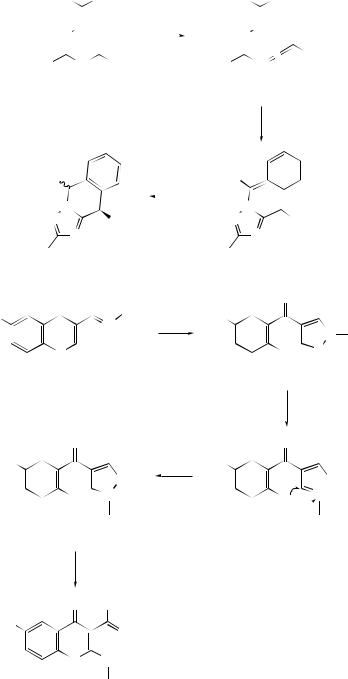
538 |
Organic Reaction Mechanisms 1998 |
|
Ph |
Ph |
Ph |
|
Ph |
|
||||
|
|
|
|
|
|
|
|
|
|
|
|
|
N |
|
|
Ph3P |
N |
N |
|
||
|
N |
O |
|
|
• |
Ph |
||||
|
|
|
||||||||
|
|
|
|
|
|
|
|
|
||
Me |
|
N |
|
R |
Me |
|||||
|
|
N |
|
|||||||
|
|
H |
|
|
|
|
|
|
|
|
|
R = PhCH2 |
|
(144) |
|
||||||
Ph |
|
|
|
Ph |
+ |
|
|
|
|
|
|||
|
|
|
|
|
|
|
|
N |
|
|
N |
− |
|
N |
Ph |
|
|
N |
Ph |
|
|
|
|
|
|||
|
N |
|
|
|
N |
|
Me |
|
|
|
Me |
|
|
|
|
SCHEME 56 |
|
|
||
|
O |
|
|
R |
|
+ |
Ph |
|
|
||
N
O−
O
(145)
O
R
O
O N
N
Ph
O H
R
O
H
O N
Ph
(148)
O
R
N Ph
O O
O
(146)
O
R
+  O
O
O−  N
N
Ph
(147)

15 Molecular Rearrangements |
539 |
formation of 2-(N -phenylamino)-4-oxo-4H [1]benzopyran-3-carboxaldehydes (148) as major products from C-(4-oxo-4H [1]-benzopyran-3-yl)-N -phenyl nitrones (145) on heating the latter in benzene, has been rationalized252 in terms of an initial 1,5-electro- cyclization to give intermediate (146) which is converted into the chromone ring-opened intermediate (147) which, after recyclization followed by a [1,5]-hydrogen shift, affords (148).
The formation of cyclic nitrones (150) from ω-alkenyl oximes (149) has been shown to proceed via a concerted pericyclic mechanism.253 Kinetic and computational studies have provided evidence for the involvement of a novel pseudo-pericyclic electrocyclization in the conversion of o-vinylphenyl isocyanates into quinolin-2- ones.254 Such reactions have also provided evidence of torquoselectivity in a 6π system. Flash vacuum thermolysis of triazoles (151) has been found to afford dihydroquinolines (155), presumably by generation of α-oxoketenimines (152) which can undergo a [1,5]-hydrogen shift to the o-quinoid imines (153)/(154) and subsequent electrocyclization255 (see Scheme 57).
H
Me
O |
|
|
• |
|
−O + |
|||||||
|
|
|
|
N |
||||||||
|
N • |
|
||||||||||
|
|
|
|
|
O |
|
|
|
|
|
|
O |
Ph |
|
|
Ph |
|||||||||
|
|
|
|
|
|
|
|
|
|
|||
|
|
|
|
|
|
|
|
|||||
|
|
|
|
|
|
|
|
|
|
|
|
|
|
|
|
O |
|
|
O |
||||||
|
(149) |
(150) |
||||||||||
Non-stabilized α, β : γ , δ-unsaturated azomethine ylides (158), generated by the decarboxylation method from 3,3-diarylpropenals (156) and secondary amino acids (157), have been found256 to undergo [1,7]-electrocyclization followed by a [1,5]- hydrogen shift, to yield 2,3-dihydro-1H -2-benzazepines (159).
The intramolecular 4 + 2-cycloaddition of conjugated ynones, e.g. (160), has been shown257 to produce, initially, highly strained heterocyclic allenes (161) which undergo an unusual rearrangement leading to polycyclic furans (162) (see Scheme 58). The dimeric derivatives of 1,1,2,2-tetraethynylethene, viz. (163), have been found to undergo an unexpected rearrangement to a permethylenated cycloocta-1,5-diyne (164) in the presence of acid. Formation of (164) has been rationalized258 by assuming a cascade mechanism consisting of electrocyclic or radical reactions. In the first step, thermal cleavage of the carbon–carbon bonds in both dioxolane rings occurs by a conrotatory 12π -electrocyclic ring opening. A formal intramolecular 4π + 4π - cycloaddition between the central butatriene units of the intermediate would finally result in the formation of the strained cycloocta-1,5-diyne system. The photochemical reaction of a series of enediynes to yield a cyclization product identical to that which would be expected from a thermal Bergman rearrangement has been reported.259 Reaction coordinates have been computed260 for the Bergman cyclization of hex- 3-en-1,5-diyne and neutral and protonated 3-azahex-3-en-1,5-diyne.
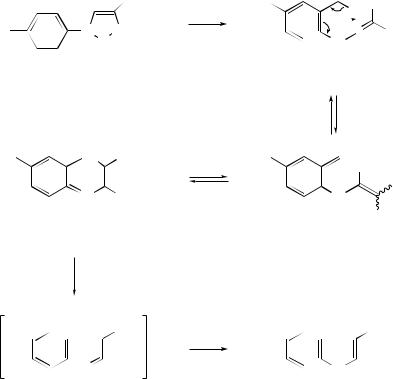
540
COR
R′ |
|
N N |
|
|
N |
|
|
|
|
(151) |
|
R′ |
H |
|
COR |
|
N |
|
H |
|
|
||
|
|
||
|
(154) |
|
|
R′

 COR
COR
N
Organic Reaction Mechanisms 1998
R′ |
H |
H
 • COR
• COR
N
(152)
R′
H
H
N
COR
(153)
R′

 COR
COR
N
H
(155)
SCHEME 57
The ruthenium-catalyzed Alder ene addition of alkenes and alkynes has provided a powerful new method for the construction of complex organic molecules.261 The ene reaction between propene and various enophiles has been examined262 by ab initio methods. The transition structures were all found to be cyclic and the reactions found to be concerted. The complex trans-[Ru(salen)(NO)(H2O)]+ has been found to catalyse the ene reaction between activated enophiles and alkenes to yield homoallylic alcohols by a stepwise process.263 High enantioselectivity has been achieved264 in the ene reactions of n-butylglyoxylate to α-methylstyrene using multi-component titanium catalysts, while bidentate bis(oxazolinyl)Cu(II) complexes have been established265 as highly selective catalysts for the glyoxylate–ene reaction. Scandium trifluoromethanesulfonate has been found to act as an efficient catalyst for both intraand intermolecular carbonyl-ene reactions.266 Not surprisingly, different cyclization products have been obtained in the ene cyclization of 5-methyl-2-(1-methylethyl)-hex-5-enal when different Lewis acids are used.267 A facile and diastereoselective route to various chiral β-amino acids has been developed268 using the carbonyl–ene reaction of
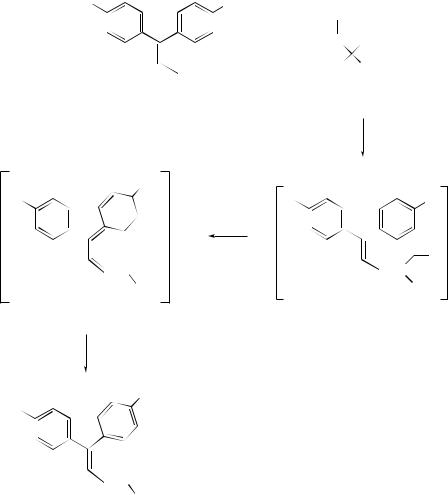
15 Molecular Rearrangements
R1 |
R1 |
+
 O
O
(156)
R1
R1 |
R1 |
 R3
R3
 N
N
R2
R1
R1
 R3
R3
 N
N
R2
(159)
541
R2
HN CO2H
HR3
(157)
R1
+ − R3
 N
N
R2
(158)
N -tritylaziridine-2-(S)-carboxaldehyde. The application of a novel, sequential, transacetalation oxonium ene cyclization has delivered269 a stereoselective synthesis of the C-aromatic taxane skeleton, and a combinatorial sequence of the regioselective propiolate–ene, catalytic enantioselective epoxidation and carbonyl–ene cyclization reactions has been used270 to complete the synthesis of the A-ring of a vitamin D hybrid analogue.
Allenic esters (165) have been found271 to undergo a retro-ene reaction on flash vacuum thermolysis above 800 ◦C to give unsubstituted vinylketene together with formaldehyde or acetaldehyde (see Scheme 59).
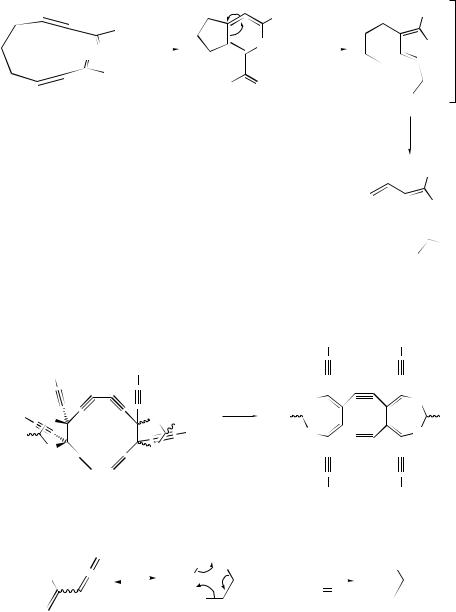
542 |
Organic Reaction Mechanisms 1998 |
|
|
|
|
|
|
|
|
|
|
|
Me |
||
|
|
|
|
|
Me |
|
|
||||||
Me |
|
|
|
|
|
|
•• |
||||||
|
|
|
|
|
|
|
|
|
|
||||
|
|
|
|
|
O |
|
|
|
|
|
O |
||
O O |
|
|
|
||||||||||
|
|
|
|
|
|
|
|
|
|
||||
Me |
|
O |
|
|
|
|
|
|
O |
||||
|
|
|
|
Me |
|
|
|
|
|
|
|||
|
|
|
|
|
|
|
|
Me |
|||||
(160) |
|
|
|
|
(161) |
|
|
|
|
|
|||
|
|
|
|
|
|
|
|
|
|
|
|
||
Me
O
 O
O
|
|
|
Me |
|
|
|
(162) |
|
SCHEME 58 |
|
|
|
|
TIPS |
TIPS |
TIPS |
TIPS |
|
|
|
|
O |
O |
TIPS O |
O OEt |
EtO |
OEt |
EtO |
TIPS |
O |
O |
O |
O |
|
|
|
|
TIPS |
TIPS |
|
(163) |
|
(164) |
|
|
O |
|
RR′C |
|
X |
|
|
H |
|||||||||||||
RR′CHX |
• |
|
|
∆ |
|
|
∆ |
|
||||||||||||||
|
|
|
|
H |
|
|
|
|
O |
|
|
|
|
• |
|
O |
||||||
|
|
|
|
|
|
|
|
|
|
|
|
|
|
|
|
|
||||||
|
|
|
|
|
|
|
|
|
|
|
−RR′C X |
|
|
|
|
|
||||||
|
|
|
|
|
|
|
|
• |
|
|
|
|
|
|
|
|
|
|
|
|
|
|
|
|
|
|
|
|
|
|
|
|
|
|
|
|
|
|
|
|
|
|
|
|
|
|
|
|
|
|
|
|
|
|
|
|
|
|
|
|
|
|
|
|
|
|
|
|
(165)
X = O or NMe
SCHEME 59
15 Molecular Rearrangements |
543 |
A novel stereoelectronic effect rather than intramolecular hydrogen bonding or steric congestion has been shown to determine the threo-diastereoselectivity in the ene reaction of singlet oxygen with an electron-poor allylic alcohol and its ethers.272 The effect of solvent polarity on the photo-oxygenation of 2,4-dimethylpenta-1,3-diene has been studied. The differences observed in the ene and 4 + 2-cycloaddition reactions in different solvents have been explained273 by competition between a concerted and a perepoxide mechanism. Dramatic diastereoselectivity differences have been observed in the asymmetric ene reactions of triazolinediones and singlet oxygen with chiral 2,2-dimethyloxazolidine derivatives of tiglic acid. These differences have been rationalized274 in terms of the differences in steric demand of the singlet oxygen and triazolinedione enophiles rather than electronic factors. It has been shown for the first time that the phenyl ring of styrene substrates can dictate the syn/anti stereochemistry in their ene reactions with singlet oxygen and triazolinediones. The authors275 have proposed that a favourable interaction of the enophiles with the phenyl ring directs the orientation of perepoxide or aziridinium imide. Recent studies276,277 have shown that the ene reactions of triazolinediones with chiral allylic alcohols exhibit high threo- diastereoselectivity in non-polar solvents, whereas in polar solvents the diastereoselectivity was shown to decrease substantially. These results support a favourable interaction occurring between the hydroxyl group of allylic alcohols and triazolinediones in the transition state of aziridinium imide formation. This steering effect occurs either between the negatively charged nitrogen during the formation of the aziridinium imide where the triazolinedione is placed syn to the hydroxyl, or between the carbonyl group of the triazolinedione and the hydroxyl, in the transition state where the enophile is placed anti to OH. These studies have further substantiated the mechanistic equivalence between triazolinedione and singlet oxygen enophiles. Convenient syntheses of 1-deoxy-neo-inositol and 1-deoxy-myo-inositol have been achieved278 using ene reactions of singlet oxygen. Heterocyclic ketene aminals bearing a secondary enamine moiety have been found to undergo an efficient aza–ene reaction with 4-phenyl-1,2,4- triazolin-3,5-dione279 (see Scheme 60).
The diastereofacial selective imine–ene reactions with α-imino esters prepared from (−)-8-phenylmenthyl glyoxylate have provided280 an efficient entry to the asymmetric synthesis of α-amino acids, and a Lewis acid-mediated intramolecular imine–ene reaction has been used for the key spirocyclization step in a recent synthesis of (−)-perhydrohistrionicotoxin.281 Asymmetric azo–ene reactions have been effected using the chiral azo–enophile, di-(−)-(1R,2S)-2-phenyl-1- cyclohexyldiazenedicarboxylate.282
Ene reactions of Pummerer-type reaction intermediates have been used as key steps in the synthesis of both pellitorine283 and trichonine.284
The effect of ring substituents on the rate constants, deuterium kinetic isotope effects and Arrhenius parameters for ene-additions of acetone to 1,1-diphenylsilane have been explained285 in terms of a mechanism involving fast, reversible formation of a zwitterionic silene–ketone complex, followed by a rate-limiting proton transfer between the α-carbonyl and silenic carbon. A study286 of the thermal and Lewis acid-catalysed intramolecular ene reactions of allenylsilanes with a variety of

544 |
|
|
|
|
|
|
|
|
|
Organic Reaction Mechanisms 1998 |
|||||||
|
O |
Ar |
|
|
|
O |
|
|
|
|
O |
Ar |
|
|
|
||
|
|
|
|
|
|
|
R |
|
|
|
O |
||||||
R |
|
|
|
|
|
|
|
|
|
|
H |
||||||
|
|
|
|
|
|
|
|
|
|
||||||||
|
|
|
|
N |
|
|
|
N |
|
|
|
|
|
|
|||
N |
|
+ |
Ph |
N |
|
|
|
||||||||||
H |
|
|
N |
|
|
|
N |
|
Ph |
||||||||
|
|
|
|
|
|
|
|
|
|
||||||||
|
|
|
N |
|
|
|
|
N |
N |
|
|||||||
|
|
|
|
|
|
|
|
|
|
|
|||||||
|
N |
|
|
|
|
|
|
|
|
|
|
|
|
||||
|
H |
|
|
|
O |
|
|
|
|
n |
H |
|
|
|
|||
|
n |
|
|
|
|
|
|
|
|
|
|
|
O |
||||
|
|
|
|
|
|
|
|
|
|
|
|
|
|
|
|||
|
O |
Ar |
|
O |
Ar |
|
|
|
||||||
R |
|
O |
R |
H |
O |
|||||||||
|
|
|
|
|
|
|||||||||
N |
N |
N |
|
|
|
|||||||||
N |
|
|
|
|||||||||||
|
|
|
|
|
|
|
|
|||||||
|
NH |
|
N |
|
Ph |
|
|
|
|
|
|
N |
|
Ph |
|
N |
|
N |
N |
|
|
|
|||||||
|
n H |
|
|
|
|
|
|
n |
H |
|
|
|
||
|
|
|
O |
|
|
|
|
|
O |
|||||
|
|
|
SCHEME 60 |
|
|
|
|
|
|
|
|
|||
enophiles has shown that, in all cases studied, the cycloaddition reactions were stereoselective. The results of the Lewis acid-catalysed ene reactions of allylic silenes and stannanes with methyl propiolate have been described.287 They indicated clearly that the chemoselectivity of these reactions was extremely dependent on the identity of the metallic group and the nature of the ene and enophile. Diels–Alder and ene reactions of ethenes Me2M=C(SiMe3)2 [M = Si, Sn, Ge] have been shown to take place both regioand stereo-selectively and the results have been explained288 by the π –π energy differences, the double-bond polarities and the M−C bond energies. A highly diastereoselective synthesis of (−)-erythrodiene has been achieved using an intramolecular Pd-catalysed zinc–ene reaction as the key step.289 Applications of the phospha–ene reaction to the synthesis of different classes of organophosphorus compounds have been reviewed.290
Anionic Rearrangements
The mechanism of [1,2]-methyl Wittig migration in the free and lithiated anionic methoxymethide model system has been discussed.291 The study has provided, on the one hand, a picture of the free anion processes taking place in the gas phase and, on the other hand, two extreme descriptions of ionic association relevant to the condensed phase. It has been reported292 that in the [1,2]-Wittig rearrangement of enantio-defined stannanes such as (166), the normal tendency for the α-oxylithium species to undergo an inversion of configuration [see (166) → (167)] can be suppressed and even overturned by the chelation effect [see (166) → (168)]. Experimental evidence has been provided293 to suggest that a cyclization–Wittig-type [1,2]-migration best accounts for the rearrangement of deprotonated benzyl benzoate to the diphenylmethoxide anion and carbon monoxide. Thus cyclization of PhCO2−CHPh yields deprotonated
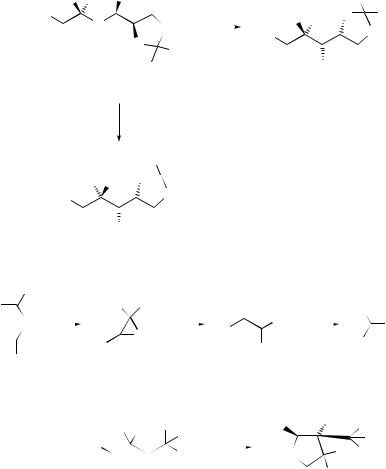
15 Molecular Rearrangements |
|
|
|
|
|
|
545 |
Bu3Sn H Ph |
|
|
|
|
|
|
Me |
Me |
|
|
|
HO |
H |
O |
Me |
O |
O |
|
|
|
|
||
|
|
Me |
|
|
O |
||
|
|
|
|
||||
O |
|
|
|
|
|||
|
|
|
|
|
|
||
|
Me |
|
|
|
|||
|
|
Ph |
|
|
|||
Me |
|
|
|
|
|
|
|
(166) |
|
|
|
|
(167) |
|
|
|
|
|
|
|
|
Me |
|
|
|
|
|||||||
|
|
HO H |
O |
|
Me |
|
|
|
|
||||||||
|
|
|
|
|
|
|
|
|
|
|
|
|
|
|
|||
|
Me |
|
|
|
|
|
|
O |
|
|
|
|
|||||
|
|
|
|
|
|
|
|
|
|
|
|
|
|
|
|
|
|
|
|
|
|
|
|
|
|
|
|
|
|
|
|
|
|
|
|
|
|
Ph |
|
|
|
|
|
|
|
|
|
|
|
|
|
||
|
|
(168) |
|
|
|
|
|
|
|
|
|
|
|
|
|
||
O |
|
|
|
O− |
|
|
|
O |
|
|
|
|
|||||
Ph |
Ph |
|
|
|
|
|
|
Ph |
|||||||||
|
|
|
|
|
|
|
|
|
|||||||||
O |
|
|
|
|
|
|
|
|
|
|
|
|
|
Ph |
|
|
O− + CO |
|
|
|
|
O |
|
|
|
Ph |
|
|
|||||||
|
|
|
|
|
|
|
|
|
|||||||||
− |
|
|
|
|
|
|
|
|
|
Ph |
|||||||
Ph |
|
|
|
|
|
|
O− |
|
|
||||||||
|
|
|
|
|
|
|
|
|
|
|
|||||||
Ph |
|
|
|
|
|
|
|
|
|
|
|
|
|||||
|
|
|
|
|
|
|
|
|
|
|
|
|
|
|
|
||
|
|
|
|
|
|
|
|
|
SCHEME 61 |
|
|
|
|
||||
|
|
Me |
Me |
Me |
Ar |
OH |
Me |
||||||||||
|
|
|
|
||||||||||||||
|
Ar |
O |
|
|
|
|
R |
|
|
|
R |
||||||
|
|
|
|
|
|
|
|
|
|
|
|
|
|||||
|
|
|
|
|
|
|
|
|
|
|
|
Me Me |
|||||
|
|
|
|
|
Me |
O |
|
||||||||||
|
|
− |
|
|
|
|
|
||||||||||
|
|
|
|
|
|
|
|||||||||||
|
|
|
|
|
O |
|
|
|
|
|
|
|
Me |
|
|||
|
|
(169) |
|
|
|
|
|
|
|
|
|
|
(170) |
|
|||
diphenylhydroxyoxirane which undergoes ring opening to afford deprotonated deoxybenzoin which then dissociates via an anionic [1,2]-Wittig-type rearrangement (see Scheme 61).
It has been shown294 that the α-carbanion of an alkyl benzyl ether such as (169) undergoes nucleophilic addition to a carbonyl moiety existing in the same molecule [see (170)] without Wittig rearrangement or protophilic decomposition. The mechanism shown in Scheme 62 has been postulated295 to account for the formation of benzil from O-benzoylbenzaldehyde cyanohydrin in a reversible base-catalysed reaction. Triphenylbismuthonium 2-oxoalkylide (171), generated in situ from the corresponding oxonium salt and base, has been shown to react with 1,2-diketones to yield O-aroyl enolates of unsymmetrical 1,3-diketones (172) via a carbon to oxygen migration of
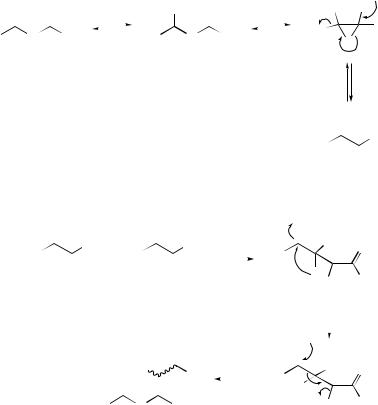
546 |
|
|
|
|
|
|
|
|
|
|
|
Organic Reaction Mechanisms 1998 |
|||||
|
CN |
O |
|
|
|
CN |
O |
|
|
|
|
|
Ph O− |
||||
|
|
|
|
|
|
base |
|
|
|
|
|
|
|
|
NC |
Ph |
|
|
|
|
|
|
|
|
|
|
|
|
|
||||||
Ph |
O |
|
|
Ph |
|
|
|
Ph − |
O |
Ph |
|
|
|
||||
|
|
|
|
|
|
|
|
||||||||||
|
|
|
|
|
|
|
|
O |
|||||||||
|
|
|
|
|
|
|
|
|
|
|
|
|
|
|
|
|
|
|
|
|
|
|
|
|
|
|
|
|
|
|
|
|
|
|
|
|
|
|
|
|
|
O |
|
|
|
||
|
|
|
|
|
|
|
|
|
|
|
|
|
|
|
|
|
|
|
|
|
|
|
|
|
|
|
|
|
Ph |
|
|
|
|
|
|
|
|
|
|
|
|
|
|
|
|
|
|
|
|
|
|
|
Ph |
||||||
|
|
|
|
|
|
|
|
|
|
|
|
|
|
|
|
|
|
|
|
|
|
|
|
|
|
||||
|
|
|
|
|
|
|
|
|
|
|
|
|
|
|
|
|
|
|
|
|
|
|
|
|
|
||||
|
|
|
|
|
|
|
|
|
|
|
|
|
|
|
|
|
|
|
|
|
|
|
|
|
|
|
|
|
|
|
|
|
|
|
|
|
|
|
|
|
|
|
|
|
|
|
|
|
|
|
|
|
|
|
|
|
O |
||
|
|
|
|
|
|
|
|
|
|
|
|
|
SCHEME 62 |
|
|
|
|
|
|
|
|
|
|
|
|||||
|
|
|
|
|
|
|
|
|
|
O |
|
O |
|
|
|
|
|
|
|
||||||||||
+ |
− |
|
|
|
|
R |
|
|
|
|
|
|
|
|
|
Ar |
|
|
|
|
Ar |
|
O |
||||||
|
|
|
|
|
|
|
|
|
|
|
|
|
|
|
|
|
|
|
|
|
|
|
|||||||
Ph3Bi |
|
|
|
|
|
+ |
|
|
Ar |
|
|
|
|
|
|
|
|
|
|
Ar |
O− + |
|
|
|
|||||
|
|
|
|
|
|
|
|
|
|
|
|
|
|
|
|||||||||||||||
|
|
|
|
|
|
|
|
|
|
|
|
|
|||||||||||||||||
|
|
O |
|
|
|
|
|
|
O |
|
|
|
|
|
R |
||||||||||||||
(171) |
|
|
|
|
|
|
|
|
|
|
|
|
|
|
|
|
|
|
|
|
|
BiPh3 |
|
||||||
|
|
|
|
|
|
|
|
|
|
|
|
|
|
|
|
|
|
|
|
|
|
|
|
|
|
|
|
||
|
|
|
|
|
|
|
|
|
|
|
|
|
|
O |
|
O− |
|
|
|
|
|
|
|
||||||
|
|
|
|
|
|
|
|
|
|
|
|
|
|
|
|
|
|
|
|
|
|
||||||||
|
|
|
|
|
|
|
|
|
|
|
|
|
|
|
|
|
|
|
|
|
|
||||||||
|
|
|
|
|
|
|
|
|
H |
|
|
|
|
|
|
R |
|
|
Ar |
Ar |
|
O |
|||||||
|
|
|
|
|
|
|
|
|
|
|
|
|
|
|
|
||||||||||||||
|
|
|
|
|
|
|
O |
|
|
|
|
|
|
|
|
|
|
|
|
|
|
|
|||||||
|
|
|
|
|
|
|
|
|
|
|
|
|
|
|
|
|
|
|
|
O |
+ |
|
|
|
|
R |
|||
|
|
|
|
|
|
Ar |
|
|
O |
|
|
|
|
Ar |
|
|
|
|
BiPh3 |
|
|||||||||
|
|
|
|
|
|
|
|
|
|
(172) |
|
|
|
|
|
|
|
|
|
|
|
|
|
|
|
|
|||
SCHEME 63
the aroyl moiety296 (see Scheme 63). This type of carbon–carbon bond construction based on 1,2-carbonyl migration is unprecedented in ylide chemistry. It has been proposed297 that the formation of products such as (176) from the oxidation of 1,3-dicarbonyl compounds of the type (173) with (camphorylsulfonyl)oxaziridines involves initial generation of the α-alkoxy-β-keto ester anion (174) which rearranges via the alkoxy epoxide (175). Wasabidienone A (178) has been synthesized298 via a novel rearrangement reaction of an acyl group from carbon to the β-hydroxy oxygen on a cyclohexadienone ring (177).
The formation of fluorinated α-hydroxy-β-imino esters (180) by treatment of fluorinated imino ethers (179) with lithium 2,2,6,6-tetramethylpiperidide has been reported.299 A possible explanation for this interesting intramolecular rearrangement is proposed in Scheme 64. Acyclic imides derived from primary benzylic amines and amino acid esters have been found to undergo a novel nitrogen to carbon acyl migration via a base-generated carbanion to yield the corresponding α-amino
